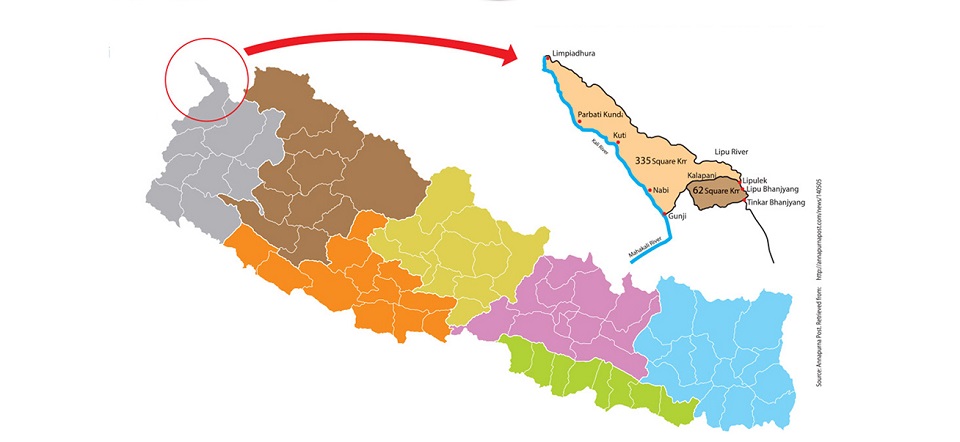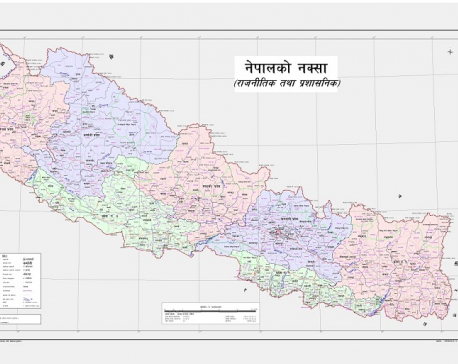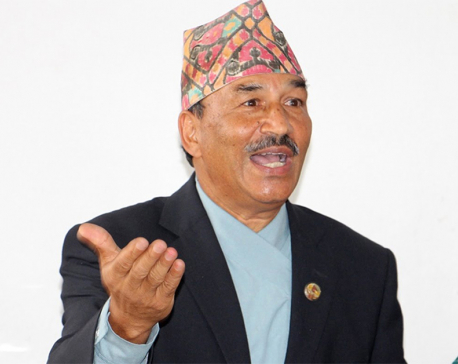
OR
Way to solve India-Nepal border dispute
Published On: May 29, 2020 03:00 PM NPT By: Bishnu Raj Upreti

More from Author
There is no other option to bilateral dialogue and negotiation to resolve the border dispute. Non-cooperation and inaction will result in ‘lose-lose’ outcome for India and Nepal.
Border, boundary, or territorial disputes arise from the claim and counterclaim over land, freshwater, minerals, etc by the bordering countries. They often erupt from encroachment, geopolitical rivalry, locational confusion among others. There are numerous boundary conflicts across the globe. In 2014, there were more than 150 notable border disputes across the world (ranging from Africa, Asia, America, Pacific, and Europe to even Antarctica) and this figure is even increasing now. Some of the most prominent border disputes are between Russia-Ukraine (Crimea), India-Pakistan (Kashmir), and Israel-Palestine. According to the Encyclopaedia Britannica East China Sea dispute between Japan and China for the control of energy-rich Senkaku (Diaoyu) Islands is one of the eight most intense border disputes. Many border disputes are unsettled for decades some of them are settled by mutual agreements or by the Internal Court of Justice of the UN.
India is one of the countries having frequent border disputes with her neighbours like Pakistan, Nepal, China and Bangladesh. Nepal is much older state than India. Nepal had expanded its territory up to the Tista River in the East, Kangada fort in the West and confluence of the Ganga River in the south. However, Nepal lost Anglo-Nepal War of 1814-16 and had to sign the Sugauli Treaty on March 4, 1816 through which Nepal lost huge area between Mechi to Tista in the East, Mahakali to Satlaj in the west and huge plain area in the south.
In 1860, the British rulers returned Banke, Bardiya, Kailali and Kanchapur (also called as Naya Muluk) to Nepal as reward to the Junga Bahadur Rana when he helped British rulers to suppress mutiny of 1857-59, which was formalized through a supplementary boundary treaty. Since then the boundary between these two countries has been fixed.
Source of problem
According to the experts, the problem started after 1879 when the British rulers changed name of the original Kali River originating from Limpiyadhura to Kuti Yangdi and the small river originating from Lipu Lekh was labeled as Kali River in the maps they produced and referred it as the border between India and Nepal. This is the real source of dispute.
Several historical evidences show that the territory east of Kali River defined by the Article 5 of the 1816 Sugaili Treaty belongs to Nepal. There are also other anecdotal evidences such as a) personal account of the person conducting population census in those areas b) local people’s participation in the parliamentary elections of 1959 from the Gunji, Navi and Kuti villages East of Kali River and c) Tax payment and land registration records of this area.
In June 1952, 18 Indian military check posts were installed in the Nepal-China border during the Premiership of Matrika Prasad Koirala. Prime Minister Kirti Nidhi Bista, on April 20, 1969, removed 17 of 18 check posts but the one in Kalapani was remaining. The Kalapani area was controlled by Indo-Tibetan Border force since the Indo-China War of 1962 and Nepal was not able to remove it. Since then India has controlled the disputed areas and prevented access of Nepal.
Several other boundary disputes between India and Nepal were observed and many of them were resolved by Nepal-India Joint Technical Level Boundary Committee established in November1981 (which worked until it was dissolved in January 2008) except Susta and Kalapani. Hence, the Joint Press Statement on the third meeting of India-Nepal Joint Commission (Co-Chaired by Indian foreign minister Sushma Swaraj and Nepal FM Mahendra Bahadur Pandey) from 25-27 July, 2014 in Kathmandu agreed to assign the task of resolving the boundary dispute to the Foreign Secretaries of both countries with no progress. Instead, the joint statement issued on May 15, 2015 during the official visit of the Prime Minister of India to China revealed that India and China signed agreement for trade and transit route via Lipu Lekh. Immediately Nepal sent diplomatic notes to India and China protesting this agreement.
Further, in November 2019, India unilaterally issued a new political map including Kalapani area in it and on May 8, the Indian Defense Minister inaugurated 80-km link road crossing Lipu Lekh to Kailash Mansarovar from Pithoragath district, near the India-Nepal-China tri-junction ignoring the diplomatic notes of Nepal. These all-unilateral actions of India forced Nepal to issue diplomatic note to the Indian government and to summon Indian Ambassador to Nepal. However, India took strategy of ‘avoidance and inaction’ citing COVID-19. Instead, Indian Army Chief General Manoj M Naravane on May 15 said that Nepal’s protest against a newly built road was at “someone else’s behest”. It was an insult to a sovereign country. This is why on May 18, 2020, the cabinet approved a new political map showing Limpiadhura-Kalapani-Lipulek as parts of Nepal’s territory.
Since then Indian media, analysts and retired officials have been blaming Nepal, threatening or even misinterpreting the reality.
Settling the dispute
The global history of border disputes shows that they are settled from mutual negotiation based on evidences and pragmatism. Current Indian approach does not seem to be negotiation-friendly. It seems directed to pressure Nepal to give up. Of course, Nepal and India have the special ties and roti-beti ka rista but this does not mean that Nepal has to surrender its territory. The open border, cultural, religious, linguistic relations, mutual inhabitation and interdependence applies to both countries.
Nepalis are serving in Indian Gurkha, many Indians work in Nepal and are sending money back home, much more than what Nepalis bring to Nepal from India.
Indian media have shifted the blame on China and intra-party and inter-party power struggles. This is far from the truth. There is unity across the parties and among the people on the issue of Limpiadhura-Kalapani-Lipulekh land. Nepal has consistently been requesting to settle this dispute by diplomatic dialogue between the two countries. Diplomatic dialogue is the only way to resolve the boundary issues. And this will be possible when Nepal and India agree on the following: 1) respecting sovereignty of each other but also making some concessions if necessary, 2) accepting the jurisdiction of each other, 3) agreeing to maintain the status quo, 4) agreeing to make international law the basis for negotiation, 5) fostering mutual confidence and commitment to settle dispute with mutual respect, 6) aiming for win-win outcome, 7) being focused on real issues, 8) considering sentiments, emotions, historical relations, interdependence in the equal footing, 9) creating conducive environment (such as by receiving EPG report, settling the demonetization effect) and 10) identifying right time and favourable context.
Indo-Nepal border dispute can be resolved if India abides by the following five complimentary principles: 1) Mutual respect in the spirit of the speech delivered by Prime Minister Narendra Modi in Nepal’s Constituent Assembly on August 3, 2014 and the popular statement of his predecessor Atal Bihari Vajpayee who had said ‘relations between Nepal and India are higher than the Himalayas and deeper than the ocean’, 2) Use of historical evidences (treaty documents, maps, letters, memos, agreements, etc) and reality (any unilateral claims and justifications must be subject to bilateral discussion and acceptance), 3) Use of modern science and technology to determine the contested source of Mahakali River, 4) Listening to the experts and 5) Vision and determination of the highest level political leadership to settle this dispute through negotiated settlement.
Avoidance and or inaction will only make the matters more complicated. There is no other option to bilateral dialogue and negotiation to resolve the border dispute. Non-cooperation and inaction will result in ‘lose-lose’ outcome for India and Nepal.
The author is Executive Chairman of Policy Research Institute
You May Like This

How to deal with Nepal? India may take a leaf out of British Raj
Indians often pursue the legacy of the British Raj while executing their foreign policy. The maritime security has become a... Read More...

Commentary: Indian media's blame China strategy is complicating the Lipu Lekh issue
KATHMANDU, May 22: Nepal's objection to India's unilateral inauguration of a road through Lipu Lekh, a sovereign Nepali territory, two... Read More...

India is to be blamed for artificial enlargement of territory: Former foreign minister Thapa
KATHMANDU, May 21: Former foreign minister Kamal Thapa has said that India is to be blamed for the tension that... Read More...





Just In
- Nepalgunj ICP handed over to Nepal, to come into operation from May 8
- Nepal to gift two elephants to Qatar during Emir's state visit
- NUP Chair Shrestha: Resham Chaudhary, convicted in Tikapur murder case, ineligible for party membership
- Dr Ram Kantha Makaju Shrestha: A visionary leader transforming healthcare in Nepal
- Let us present practical projects, not 'wish list': PM Dahal
- President Paudel requests Emir of Qatar to initiate release of Bipin Joshi
- Emir of Qatar and President Paudel hold discussions at Sheetal Niwas
- Devi Khadka: The champion of sexual violence victims




_20240423174443.jpg)










Leave A Comment